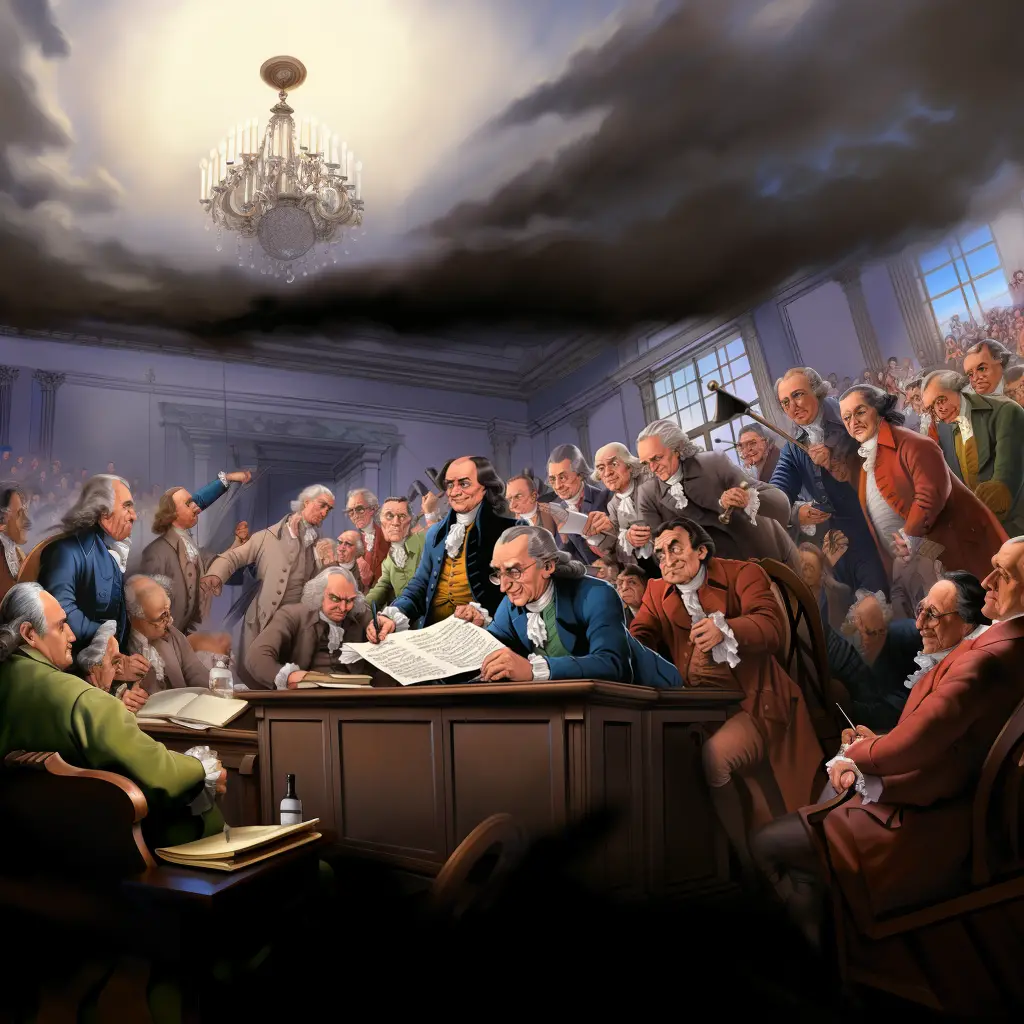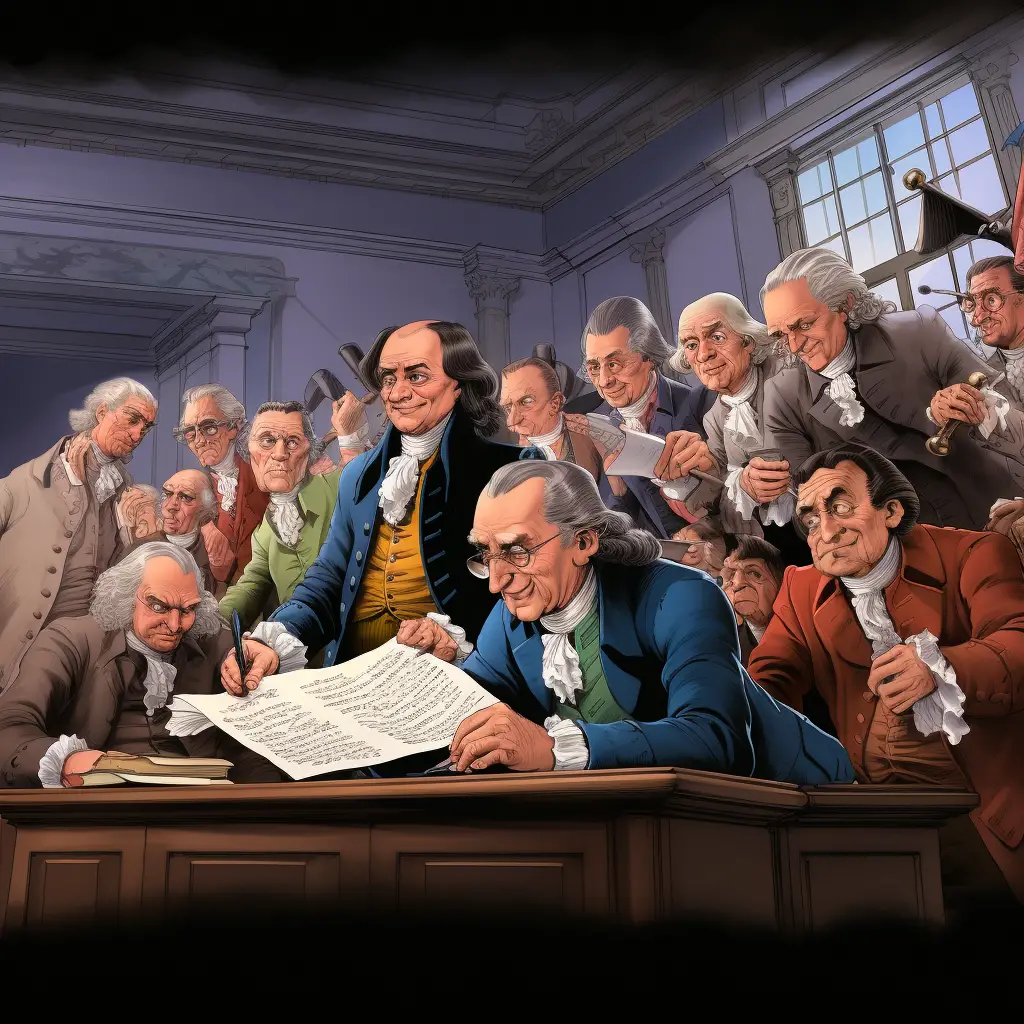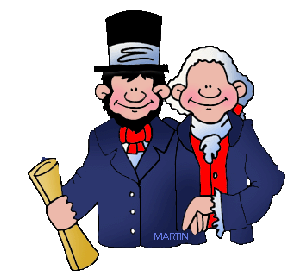Constitution
United States Constitution
During the Revolutionary War, American colonists declared independence on July 4, 1776. They adopted the Declaration of Independence and became a free country. At the same time, a committee was writing a constitution.
In November 1777, the second Continental Congress approved the first draft, the Articles of Confederation. By 1781, all thirteen states adopted it. Despite this, many leaders felt it didn’t unite the states well.
We the People of the United States, in Order to form a more perfect Union, establish Justice, insure domestic Tranquility, provide for the common defense, promote the general Welfare, and secure the Blessings of Liberty to ourselves and our Posterity, do ordain and establish this Constitution for the United States of America.

Constitution Facts For Kids
- The U.S. Constitution was signed in 1787.
- It’s the highest law in the United States.
- It begins with “We the People…”
- It created three branches of government.
- There are 27 amendments to it.
- The First Amendment protects free speech.
- The Constitution can be changed, or “amended.”
- The Bill of Rights is the first of 10 amendments.
- It was signed on September 17th.
- James Madison is called its “Father”.
Bill of Rights
The Bill of Rights is an essential part of the United States Constitution that was created to protect the freedoms and rights of all citizens. It is composed of the first ten amendments to the Constitution, which were added in 1791, four years after the Constitution itself was ratified.
These amendments guarantee basic liberties such as freedom of speech, religion, and the press (First Amendment), the right to bear arms (Second Amendment), protection from unreasonable searches and seizures (Fourth Amendment), and the right to a fair trial (Sixth Amendment), among others. The Bill of Rights is a vital part of our Constitution that helps ensure everyone’s rights are respected and protected.
Federalism in the United States
Federalism in the United States is an important concept found in the Constitution, which kids should understand. Essentially, federalism is a system of government where power is divided between a central, or federal, government and individual states.
This means that both the national government and each state have their own areas of authority. For instance, while the Federal Government can regulate interstate and foreign commerce, states have the power to control education and local law enforcement issues. This division of power helps to ensure that no single part of the government becomes too powerful, reflecting the Constitution’s aim to maintain a balance of power.
Separation of Powers
The concept of Separation of Powers is a key aspect of the Constitution that kids should understand. It is designed to ensure that no single individual or group has complete control over the government. The Constitution divides the government into three branches – the Legislative, the Executive, and the Judicial. Each branch has its own unique powers and responsibilities.
For example, the Legislative branch, which includes Congress, makes the laws, the Executive branch, led by the President, enforces the laws, and the Judicial branch, headed by the Supreme Court, interprets the laws. This division of power is designed to create a system of checks and balances, so that each branch can keep the others in check, preventing any one part of the government from becoming too powerful.
The Founding Fathers of the United States
The Founding Fathers of the United States, including figures such as George Washington, Thomas Jefferson, and Benjamin Franklin, were instrumental in the creation of the U.S. Constitution. In 1787 in Philadelphia, they spent a summer discussing, debating, and composing this crucial document.
The Constitution outlines the operation of the U.S. government and the protection of citizen rights. Remarkably, it remains the oldest written constitution currently in use, a testament to the enduring wisdom of the Founding Fathers.
Constitutional Amendments

Constitutional Amendments are changes or additions made to the U.S. Constitution. Since the Constitution was first ratified in 1788, it has been amended 27 times to ensure that it remains relevant and suited to the changing needs of the nation.
The first ten amendments, known as the Bill of Rights, were added in 1791 and offer important protections for individual freedoms and rights, like freedom of speech and the right to a fair trial. The 19th Amendment, added in 1920, gave women the right to vote.
Amendments are not easy to pass, requiring approval by two-thirds of both the House of Representatives and the Senate, and then ratification by three-fourths of the states. This process ensures that amendments reflect the will of the majority of the people.
The Federalist Papers
The Federalist Papers, a series of 85 essays by Alexander Hamilton, James Madison, and John Jay, played a significant role in shaping the Constitution. These essays explained the Constitution’s significance, outlined governmental power division, and highlighted the necessity of checks and balances. They also emphasized how the Constitution would protect individual rights, advocating for a strong central government. Comprehending the Federalist Papers provides deeper insight into the Constitution’s creation.
U.S. Supreme Court Decisions
The U.S. Constitution plays a vital role in shaping Supreme Court decisions. One interesting fact for kids about the Constitution is that it’s the supreme law of the United States, meaning all other laws must align with it. The Supreme Court, the highest legal authority in the country, uses the Constitution as a guide to interpret these laws.
If a law is believed to violate the Constitution, the Supreme Court can declare it unconstitutional, which means it’s no longer valid. This is a process known as judicial review, and it’s one of the ways the Constitution helps maintain balance and fairness in our legal system.
Articles of Confederation
The Articles of Confederation were America’s first constitution, created during the Revolutionary War. This document outlined how the 13 original states would function as a nation. However, it had several weaknesses, such as no executive branch to enforce laws, and Congress could not impose taxes.
Consequently, the Articles of Confederation were replaced by the U.S. Constitution in 1789, which established a stronger federal government with separate branches. This system allowed for more balance and flexibility, ensuring the states could coexist under a unified national government.
Constitutional Convention of 1787
The Constitutional Convention of 1787 was an important event in American history where a group of influential men, known as the Founding Fathers, gathered to create the U.S. Constitution. This convention took place in Philadelphia and lasted for four months.
The delegates at the convention decided to create a new government from scratch, instead of just fixing the existing Articles of Confederation. This decision led to the creation of a strong federal government with three branches – the executive, legislative, and judicial. This system is still used today, allowing for a balanced distribution of power.
This convention also introduced the idea of checks and balances, which ensures that no single branch becomes too powerful. The Constitution they created is now the oldest written constitution in use by any nation in the world.
Checks and Balances
The system of Checks and Balances is a vital part of the Constitution designed to prevent any one branch of the government from becoming too powerful. It works like a game of tug-of-war, making sure everyone has equal strength and control.
For instance, while the President (Executive Branch) can veto laws proposed by Congress (Legislative Branch), Congress can override that veto with enough votes. Similarly, the Supreme Court (Judicial Branch) can declare laws unconstitutional.
This ensures that power is distributed evenly and that all decisions made are fair, just, and beneficial for everyone. It’s like having three different referees in a game, all making sure the rules are followed properly.
Refining the Union: The Crucial Evolution of America’s Governmental Structure
The inability of the Articles of Confederation to adequately finance the national government left America vulnerable to external threats. A precarious situation that emphasized the imperative for substantial governmental reforms. In response to this crisis, state delegates convened in Philadelphia in February 1787. Their main task was to dissect the Articles of Confederation and strategize about effective ways to refine the existing system.
Championing Change: The Heroes of the Constitutional Convention
The Constitutional Convention, commencing in May 1787, marked the dawn of an era where the delegates were tasked with the monumental decision of designing a government that would serve the diverse needs of the nation’s populace. Following vigorous debates, a select committee of five representatives was constituted to draft the Constitution. The committee comprised of:
- John Rutledge, South Carolina
- Edmund Randolph, Virginia
- Nathaniel Gorham, Massachusetts
- Oliver Ellsworth, Connecticut
- James Wilson, Pennsylvania
The Convention reconvened in September 1787 to approve the document. Despite disagreements over certain aspects of the draft, the Constitution garnered 39 signatures and was subsequently dispatched to each state for ratification. The Constitution officially came into effect on March 4, 1789.
The Nation’s Blueprint: The Constitution and its Role in Shaping America
The Constitution ushered in with the declaration “We the People of the United States of America,” embodied the values of a free nation created and governed by its citizens. It distinctly structured America’s legislative branch—Congress, with its Senate and House of Representatives.
In addition, the Constitution delineated the executive branch, setting out the positions of President and Vice President and their respective qualifications and rules. The Constitution also established the judiciary branch, creating the Supreme Court and the American court system.
Amendments and the Bill of Rights: Safeguarding our Liberties
The Constitution allows for modifications, known as Amendments. For an Amendment to be ratified, it must receive at least two-thirds of the votes from both houses of Congress. The Bill of Rights, the Constitution’s first ten Amendments, was enacted in 1791, furnishing Americans with critical rights, such as the right to bear arms, trial by jury, and protection from unlawful search and seizure.
Among these rights, the First Amendment, endorsing the freedom of speech, embodies the ideals and aspirations of the nation’s founders, who fought relentlessly to establish a land of freedom.
Dynamic and Adaptable: The Constitution’s Ability to Evolve
The Constitution’s inherent adaptability enables it to change with its people. Congress has the authority to amend it, allowing the Constitution to respond to societal shifts. Notwithstanding its occasional imperfections—such as the overdue abolition of slavery by the Thirteenth Amendment in 1865—it has demonstrated resilience and adaptability over centuries, including during America’s turbulent Prohibition period.
A Beacon of Freedom: The Influence of the US Constitution Globally
While the Constitution may attract criticism, it has persistently united the citizens of the United States for centuries. Its influence extends beyond national borders, serving as a model for leaders from Mexico, China, and other nations in their pursuit of establishing free societies governed by the people.



